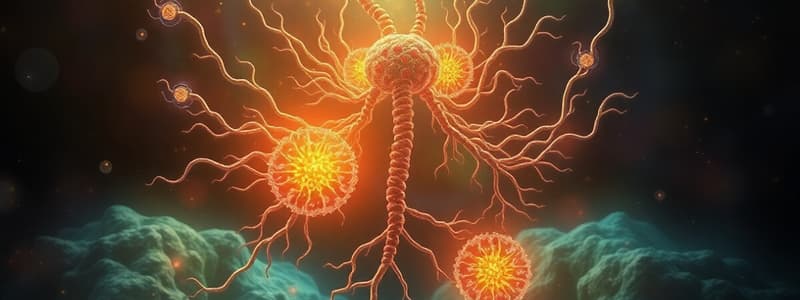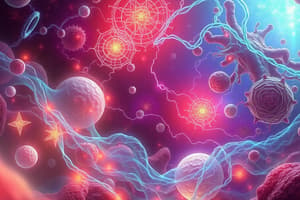Podcast
Questions and Answers
What is the primary product of alcoholic fermentation?
What is the primary product of alcoholic fermentation?
- Glucose
- Lactic acid
- Ethanol (correct)
- NADH
Which structure is formed during the secondary structure of proteins?
Which structure is formed during the secondary structure of proteins?
- Polypeptide strands
- Active sites
- Helix and pleated sheets (correct)
- Quaternary structures
What is the role of oxygen in the electron transport chain?
What is the role of oxygen in the electron transport chain?
- It is the final electron acceptor. (correct)
- It is converted into glucose.
- It acts as an electron donor.
- It serves as a substrate for ATP synthesis.
Which process occurs in the cytoplasm and does not require oxygen?
Which process occurs in the cytoplasm and does not require oxygen?
What is the end product of lactic acid fermentation?
What is the end product of lactic acid fermentation?
How many ATP are produced in total from one molecule of glucose during aerobic respiration?
How many ATP are produced in total from one molecule of glucose during aerobic respiration?
What type of fermentation is carried out by Saccharomyces?
What type of fermentation is carried out by Saccharomyces?
What is produced during the Krebs Cycle?
What is produced during the Krebs Cycle?
What occurs during the Lag phase of bacterial growth?
What occurs during the Lag phase of bacterial growth?
Which of the following terms describes organisms that require oxygen to grow?
Which of the following terms describes organisms that require oxygen to grow?
What method is used to determine the number of bacteria per milliliter using colony counts?
What method is used to determine the number of bacteria per milliliter using colony counts?
Which type of bacteria thrive in extreme acidic environments?
Which type of bacteria thrive in extreme acidic environments?
What is an example of a nutrient source that bacteria commonly require?
What is an example of a nutrient source that bacteria commonly require?
Which of the following is true of turbidimetric methods using a spectrophotometer?
Which of the following is true of turbidimetric methods using a spectrophotometer?
What is the primary focus of the Most Probable Number (MPN) method?
What is the primary focus of the Most Probable Number (MPN) method?
What is the purpose of the streak plate method in bacterial culturing?
What is the purpose of the streak plate method in bacterial culturing?
What is the role of DNA polymerase in DNA replication?
What is the role of DNA polymerase in DNA replication?
Which statement correctly describes transcription?
Which statement correctly describes transcription?
What is an Okazaki fragment?
What is an Okazaki fragment?
What type of mutation results in a premature stop codon during protein synthesis?
What type of mutation results in a premature stop codon during protein synthesis?
How does RNA polymerase differ from DNA polymerase?
How does RNA polymerase differ from DNA polymerase?
What is the primary function of transfer RNA (tRNA)?
What is the primary function of transfer RNA (tRNA)?
What occurs at the replication fork?
What occurs at the replication fork?
Which type of mutation occurs spontaneously without a mutagen?
Which type of mutation occurs spontaneously without a mutagen?
What do F plasmids primarily facilitate in bacterial cells?
What do F plasmids primarily facilitate in bacterial cells?
Which of the following statements about F- cells is correct?
Which of the following statements about F- cells is correct?
What is a primary function of transposons?
What is a primary function of transposons?
Which type of plasmid carries genes that provide resistance to antibiotics?
Which type of plasmid carries genes that provide resistance to antibiotics?
How does an F+ cell contribute to the transformation of an F- cell?
How does an F+ cell contribute to the transformation of an F- cell?
What is the primary function of structural genes?
What is the primary function of structural genes?
What happens to gene expression in the absence of lactose in an inducible operon?
What happens to gene expression in the absence of lactose in an inducible operon?
Which component is required to stop the synthesis of tryptophan in a repressible operon?
Which component is required to stop the synthesis of tryptophan in a repressible operon?
What role does allolactose play in an inducible operon system?
What role does allolactose play in an inducible operon system?
How does the presence of glucose affect the use of lactose as an energy source?
How does the presence of glucose affect the use of lactose as an energy source?
What process occurs when tryptophan levels are too high in the cell?
What process occurs when tryptophan levels are too high in the cell?
What is catabolite repression?
What is catabolite repression?
What is the effect of feedback inhibition in biochemical pathways?
What is the effect of feedback inhibition in biochemical pathways?
Flashcards are hidden until you start studying
Study Notes
Fermentation
- Occurs in the absence of oxygen
- Pyruvic acid is metabolized
- Alcoholic Fermentation
- Performed by Saccharomyces (yeast)
- Produces: 2 ethanol + 2 CO2 + 2 ATP
- Used in beer production
- Lactic Acid Fermentation
- Performed by Streptococcus, Lactobacillus, and Bacillus
- Produces: 2 lactate + 2 ATP
- Used in yogurt production
Krebs Cycle
- Occurs in the presence of oxygen
- Also known as the TCA cycle or citric acid cycle
- Products:
- Oxygen (waste)
- NADH (electron carriers, major product)
- FADH
- ATP
- It is the pathway that pyruvate enters following glycolysis
Electron Transport Chain (ETC) in Bacteria
- Occurs in the cell membrane
- Oxygen is the final electron acceptor
- Oxygen combines with hydrogen to form H2O (waste product)
- Large amounts of ATP are produced (38-40 ATP)
Calculation of ATP Production
- From 1 glucose molecule: 10 NADH + 2 FADH2 = 30 ATP + 4 ATP = 34 ATP
Oxidative Phosphorylation
- The transfer of electrons from high energy to low energy states
- With each transfer, energy in the form of ATP is captured
- High energy states release energy, which is captured as ATP
Chemiosmosis
- Conversion of ADP to ATP using the ATPase enzyme complex
- Occurs in the cell membrane
Glycolosis
- Occurs in the cytoplasm
- Glucose is converted to pyruvate
- Does not require oxygen
- Produces 2 ATP
- Breakdown of glucose and requires 2 ATP to start
Krebs Cycle
- Occurs in the cytoplasm
- Requires oxygen
- Pyruvate is converted to NADH and FADH2 (electron carriers)
- Produces 2 ATP
Electron Transport Chain
- Occurs in the cell membrane
- Requires oxygen
- Produces ATP
- Produces 34 ATP
Fermentation
- Occurs in the cytoplasm and does not require oxygen
- Lactic Acid Fermentation
- Pyruvate is converted into lactic acid
- Performed by Streptococcus, Lactobacillus, and Bacillus
- Alcoholic Fermentation
- Pyruvate is converted into ethanol and CO2
- Performed by Saccharomyces (yeast)
Protein Structures
- Peptide linkage: The formation of a peptide bond by removing H2O.
- Primary Structure: A polypeptide strand consisting of a sequence of amino acids.
- Secondary Structure: Alpha helix and pleated sheets.
- Tertiary Structure: A folded structure that combines alpha helixes and pleated sheets.
- Quarternary Structure: The combination of two or more polypeptide chains in folded states.
Binary Fission
- Cell elongation and DNA replication occurs
- Cell wall and plasma membrane begin to constrict
- A cross-wall forms, separating the DNA copies
- Cells separate
- Mother cell produces two daughter cells
- Daughter cells are exact replicas of the mother cell
- Budding is another form of cell division where a small new cell develops at the surface of the parent cell.
4 Phases of Bacterial Growth
- Lag: Preparing for growth, but no growth occurs yet
- Log: Exponential growth, increasing population
- Stationary: Growth and death of cells are equal
- Death: No more nutrients, population declines
Measuring Bacterial Growth (Pure culture only)
- Serial Dilution Method:
- A concentrated solution of bacteria culture is diluted by a series of 10 folds
- Colonies in the medium are counted.
- Example: Diluting a glass of juice with water.
- Standard Plate Count:
- Culture is added to a medium and allowed to grow
- Colonies are counted
Other Methods
- Direct Microscopic Counts: Use a counting chamber and can not distinguish dead from alive bacteria
- **Most Probable Number (MPN): ** Used for measuring small amounts of microbes in water quality studies and can't do standard plate counts
- Turbidity: A spectrophotometer is used to measure the cloudiness of a sample.
Factors Affecting Growth
- pH
- Acidophiles: Extremophiles (not pathogenic), prefer acidic environments
- Neutrophiles: Prefer neutral pH
- Alkaliphiles: Prefer alkaline environments
- Temperature
- Psychrophiles: -10-20°C
- Psychrotrophs: 0-30°C
- Mesophiles: 10-50°C (most active, our body temperature)
- Thermophiles: 40-71°C
- Hyperthermophiles: 65-110°C
- Oxygen
- Obligate aerobe: Requires oxygen
- Facultative anaerobe: Can grow with or without oxygen
- Obligate anaerobe: Requires the absence of oxygen
- Salinity/Salt:
- Nutrients:
- Carbon: Ex) glucose
- Nitrogen: Ex) ammonia, amino acids
- Sulfur: Ex) sulfur amino acids
- Phosphorus: Ex) inorganic phosphate
- Trace elements: Very small amount, used as cofactors for enzymes (micronutrients)
- Vitamins: Small amounts, used as coenzymes
Culturing Bacteria
- Streak Plate Method: Used to isolate a pure culture
- Types of Media:
In DNA
- Mutations cannot be fixed - permanent
- Mutations will be copied repeatedly
- Large mutations can be fatal
Transfer of Information
- DNA -> RNA -> Protein
- Replication: DNA polymerase: ATGC -> TACA (DNA to DNA)
- Transcription: RNA polymerase: ATGC -> UACG (DNA to RNA)
- Translation: mRNA, tRNA, rRNA: AUG/GCU/UAC/UGA = Met/Ala/Tyr/(stop) (RNA to protein)
Replication (DNA to DNA)
- Leading Strand: Synthesized continuously
- Lagging Strand: Synthesized discontinuously
- Key enzymes:
- DNA polymerase: Synthesizes complementary DNA
- RNA polymerase: Synthesizes RNA primers
- Okazaki fragments: Short DNA fragments
- DNA ligase: Seals nicks in DNA during synthesis and repair
- Helicase: Unwinds the double strand of DNA
- Origin of replication: Location on the chromosome where DNA synthesis starts
Transcription: DNA to RNA
- RNA polymerase is key enzyme
- Uracil replaces Thymine: ATGC -> UACG
Transcription of RNA:
- RNA polymerase binds with the promoter sequence and opens the DNA double helix.
- Ribonucleotides (ATP, GTP, CTP, UTP) are assembled into RNA.
- Ribonucleotides are inserted according to base pairing: G, C, A, U.
- RNA synthesis proceeds in the 5' to 3’ direction until it reaches the termination sequence, releasing the RNA.
Types of RNA
- Messenger RNA (mRNA): Translates to form a polypeptide
- Transfer RNA (tRNA): Carries amino acids to the growing polypeptide
- Ribosomal RNA (rRNA): Used in building ribosomes (machinery for synthesizing proteins)
Types of Mutations
- Spontaneous Mutation: Occurs naturally in the absence of a mutagen
- Mutagen: An agent that causes mutations
- Base Substitution: A change in one base (point mutation)
- Missense Mutation: Results in a change in the affected amino acid.
- Nonsense Mutation: Results in a stop codon, shortening the protein coded by the gene.
Structural Genes
- Code for proteins (enzymes)
- Example: Represent the output (product) that is created.
Operon
- Control region for structural genes: I P O Z Y A
- Contains regulatory elements: promoter, operator, and genes
Constitutive Genes
- Expressed at a fixed rate
- Always "on"
Inducible Genes
- Increase transcription of genes
- "Turned up" when needed
Repressible Genes
- Decrease transcription of genes
- "Turned off" it there is too much product
Gene Expression - Inducible Operon: Lactose Metabolism
- Example: lactose metabolism
- Key elements:
- I - P - O - Z - Y - A
- I: Repressor gene
- P: Promoter
- O: Operator
- Z: β-galactosidase gene
- Y: Permease gene
- A: Transacetylase gene
Absence of Lactose
- Repressor protein binds to the promoter region, blocking it
- Prevents the enzyme needed for lactose metabolism from being produced
Presence of Lactose
- Allolactose (inducer) binds to the repressor protein, inactivating it.
- The repressor protein can no longer bind to the promoter region.
- Allows for the production of the enzymes needed for lactose metabolism
Catabolite Repression
- When all glucose is consumed, the microbe will start to use lactose as an energy source.
Gene Expression - Repressible Operon: Tryptophan Synthesis
- Example: tryptophan synthesis.
- Key elements:
- I - P - O - E - D - C - B - A
- I: Repressor gene
- P: Promoter
- O: Operator
- E, D, C, B, A: Genes for the enzymes in tryptophan synthesis.
Tryptophan Synthesis - Explanation
- Tryptophan synthesis is on because the cell needs tryptophan to function.
- When there is too much tryptophan it could be detrimental, therefore, the system needs to stop it.
- An active repressor protein is used to repress the synthesis of tryptophan.
Feedback Inhibition
- A type of non-competitive inhibition
- The end product inhibits the first enzyme in the biosynthetic pathway
- End product binds to the enzyme, distorting the active site and preventing it from binding to the substrate.
- This stops the entire pathway.
Bacterial Conjugation
- The transfer of genetic material from one cell to another.
- It requires contact between the donor and recipient cells.
- It transfers much larger quantities of DNA than transformation.
- The transfer occurs in the form of plasmids (extra DNA) that provide benefits like antibiotic resistance.
F Plasmids (Fertility Plasmids)
- Circular, double-stranded DNA molecules.
- Types:
- F+ cells: Contain F plasmids and make an F pilus (sex pilus).
- F- cells: Lack F plasmids.
- F pilus: A conjugation pilus that bridges the donor and recipient cell.
- The donor cell has the F plasmid (F+)
- The recipient cell does not (F-)
- F+ creates and attaches to the F pilus
- F+ creates a copy of itself
- The copy is sent to F-
- F- becomes F+ because it now has the blueprint of the F plasmid
Types of Plasmids:
- **F plasmids/ Fertility plasmids **
- Resistance plasmids: Carry genes that provide resistance to antibiotics
- Virulence plasmids: Carry genes that cause disease (toxin genes)
- Tumor-inducing plasmids: Cause tumor formation in plants.
- Some plasmids contain genes for catabolic enzymes.
Transposons
- Jumping genes
- Mobile genetic sequences
- Can move from one location to another (transposition)
- Contain transposase: An enzyme that allows the transposon to jump and often carries genes like antibiotic resistance.
- Segments of DNA that can move within or between DNA molecules.
- Contain insertion sequences used for cutting and resealing DNA (transposase).
- Complex transposons carry other genes besides the transposase.
Transposon Example:
- ACTTACTG ATCAGTAAGT AT
- TGAATGACTA TA GTCATTCA
- Transposase gene
- ACTTACTGAT ATCAGTAAGT
- TGAATGACTA TAGTCATTCA
- Inverted repeat, Tn5, kanamycin resistance, IS1, IS1
Studying That Suits You
Use AI to generate personalized quizzes and flashcards to suit your learning preferences.




